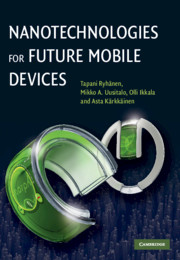Book contents
- Frontmatter
- Contents
- List of contributors
- Preface
- 1 When everything is connected
- 2 On the possible developments for the structural materials relevant for future mobile devices
- 3 Energy and power
- 4 Computing and information storage solutions
- 5 Sensing, actuation, and interaction
- 6 Future of Radio and Communication
- 7 Flat panel displays
- 8 Manufacturing and open innovation
- 9 Seeing beyond the hype: what the Internet teaches us about the development of nanotechnology
- 10 Conclusions
- Index
- References
1 - When everything is connected
Published online by Cambridge University Press: 05 July 2014
- Frontmatter
- Contents
- List of contributors
- Preface
- 1 When everything is connected
- 2 On the possible developments for the structural materials relevant for future mobile devices
- 3 Energy and power
- 4 Computing and information storage solutions
- 5 Sensing, actuation, and interaction
- 6 Future of Radio and Communication
- 7 Flat panel displays
- 8 Manufacturing and open innovation
- 9 Seeing beyond the hype: what the Internet teaches us about the development of nanotechnology
- 10 Conclusions
- Index
- References
Summary
Introduction
Mobile communication and the Internet
The Internet has created in only one decade a global information network that has become the platform for communication and delivering information, digital content and knowledge, enabling commercial transactions and advertising, creating virtual communities for cocreating and sharing their content, and for building various value adding digital services for consumers and businesses. The Internet phenomenon has been a complex development that has been influenced by several factors – an emerging culture that shares values that are brilliantly summarized by Manuel Castells [1]:
The culture of the Internet is a culture made up of a technocratic belief in the progress of humans through technology, enacted by communities of hackers thriving on free and open technological creativity, embedded in virtual networks aimed at reinventing society, and materialized by money-driven entrepreneurs into the workings of the new economy.
The Internet can be characterized by four key elements: Internet technology and its standardization, open innovation based on various open source development tools and software, content and technology creation in various virtual communities around the Internet, and finally on business opportunities created by the Internet connectivity and access to the global information. The history and the origin of mobile communication are different and have been driven by the telecommunication operators and manufacturers. Digital mobile communication has focused on providing secure connectivity and guaranteed quality of voice and messaging services. The key driver has been connection, i.e., establishing a link between two persons.
Information
- Type
- Chapter
- Information
- Nanotechnologies for Future Mobile Devices , pp. 1 - 20Publisher: Cambridge University PressPrint publication year: 2010
